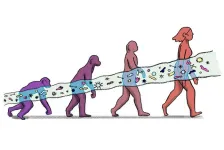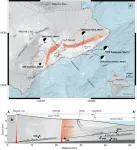(Press-News.org) How did human brains get so big? The answer could be in our gut
Microbes supporting the production of more metabolic energy could be key to the evolution of large brains
First study to show gut microbes from different animal species shape variations in their biology
Offers new take on human evolution, particularly the evolution of our large brains
Mice with large-brain primate microbes eat more, but grew slower and put on less body fat
Their bodies use the excess energy to produce high levels of glucose, which is the brain’s primary fuel source
EVANSTON, Ill. --- Brain tissue is among the most energetically costly in the body, and as a result, larger-brained mammals require more energy to support brain growth and maintenance. Exactly which biological changes allowed human ancestors to meet the very high needs for energy as they evolved larger brains has remained unclear. A new Northwestern University study points to the role of gut microbes, tiny living organisms in our digestive system that help break down food and produce energy.
In a controlled lab experiment, researchers implanted microbes from two large-brain primate species (human and squirrel monkey), and one small-brain primate species (macaque), into mice.
Their findings showed the mice with microbes from large-brain primate species produced and used more energy, while those with microbes from the small-brain species stored more energy as fat.
The data is the first to show gut microbes from different animal species shape variations in biology between animal species and supports the hypothesis that gut microbes might influence evolution by changing how an animal’s body works.
The study offers a new perspective on human evolution, particularly the evolution of our large brains.
The findings will be published in the journal Microbial Genomics on Dec. 2 at 10 p.m. CST. The article will appear online here.
Prior studies have compared the influence of genes and the environment on primates with bigger and smaller brains. However, there are very few studies comparing how different primates use energy. Even less information is available on how metabolism develops in different primate species.
“We know the community of microbes living in the large intestine can produce compounds that affect aspects of human biology — for example, causing changes to metabolism that can lead to insulin resistance and weight gain,” said the study’s first author Katherine Amato, associate professor of anthropology at Northwestern.
“Variation in the gut microbiota is an unexplored mechanism in which primate metabolism could facilitate different brain-energetic requirements,” Amato said.
After introducing the gut microbes into microbe-free mice, the researchers measured changes in mouse physiology over time, including weight gain, fat percentage, fasting glucose, liver function and other traits. They also measured differences in the types of microbes and the compounds they were producing in each group of mice.
The researchers expected to find microbes from different primates would lead to differences in the biology of the mice inoculated with them. They also expected mice with human microbes to have the greatest difference in biology from mice with microbes from the other two species.
“While we did see that human-inoculated mice had some differences, the strongest pattern was the difference between large-brained primates (humans and squirrel monkeys) and smaller-brained primates (macaques),” Amato said.
The mice given microbes from the humans and squirrel monkeys had similar biology, even though these two larger-brained primate species are not close evolutionary relatives of one another. This suggests something other than shared ancestry — likely their shared trait of large brains is driving the biological similarities seen in the mice inoculated with their microbes.
“These findings suggest that when humans and squirrel monkeys both separately evolved larger brains, their microbial communities changed in similar ways to help provide the necessary energy,” Amato said.
In future studies, the researchers hope to run the experiment with microbes from additional primate species varying in brain size. They would also like to collect more information on the types of compounds the microbes are producing and gather additional data on the biological traits of the hosts such as immune function and behavior.
About the Microbiology Society
The Microbiology Society is a membership charity for scientists interested in microbes, their effects and their practical uses. It has a worldwide membership based in universities, industry, hospitals, research institutes, schools and other organizations. It also publishes the peer-reviewed journal Microbial Genomics. Find out more at microbiologysociety.org.
For further information please contact press@microbiologysociety.org.
END
How did human brains get so big? The answer could be in our gut
Microbes supporting the production of more metabolic energy could be key to the evolution of large brains
2024-12-03
ELSE PRESS RELEASES FROM THIS DATE:
Evaluation of the phytochemical and medicinal value of lemongrass (Cymbopogon citratus), by conversion into powders and extracts to develop a nutritional bakery product
2024-12-03
Background and objectives
Because of its extraordinary phytomedicinal potential and numerous potential health benefits, lemongrass (Cymbopogon citratus), a well-known medicinal and aromatic plant, is of paramount significance. It is typically used as a drug replacement.
Methods
The present study was comprised of drying lemongrass into powder and determining the proximate and mineral composition, and then developing ethanolic extracts of powder to determine total phenolic contents (TPC), total flavonoid contents (TFC), total carotenoids (TC), and DPPH free radical scavenging activity. Next, lemongrass powder (LGP) was replaced at 0, 2.5, 5, 7.5, and 10% levels ...
Monell Chemical Senses Center and A*STAR Singapore Institute of Food and Biotechnology Innovation sign agreement to collaborate in sensory science research and education
2024-12-03
PHILADELPHIA, PA and QUEENSTOWN, SINGAPORE (Monday, Dec 2, 2024 9:30 pm EST; Tuesday, Dec 3, 2024 9:30 am SST) The Monell Chemical Senses Center, a global leader in advancing the scientific understanding of taste, smell, and related senses, and A*STAR Singapore Institute of Food and Biotechnology Innovation (A*STAR SIFBI), a translational research institute for health and well-being focused on Asian phenotype have entered into a five-year research and education alliance.
Today, Benjamin P.C. Smith, PhD, Monell Executive Director & President, met with Sze Tan, PhD, A*STAR SIFBI Executive Director, to sign a Memorandum of Understanding ...
Five new papers highlight cancer inequities, challenges and opportunities in South Asia
2024-12-03
A series of five papers, published today in The Lancet Oncology by a University of Pittsburgh-led international team, highlights critical public health challenges related to cancer control in the eight countries that form the South Asian Association for Regional Cooperation (SAARC) and the Rohingya refugee population in Bangladesh. The series underscores barriers contributing to significant disparities in cancer outcomes and identifies actionable solutions to address these challenges in one of the most comprehensive ...
Stereotypes matter: Computer science needs better role models
2024-12-03
White, male, billionaire entrepreneurs fuel stereotypes that compound the issues surrounding diversity in technology and computer science, according to a new study.
The identities of famous people contribute a lot to stereotypes in their respective domains. Prominent public figures can easily become influential to young people. But are these role models effective for creating a diverse community of computer science students? That, at this point in time, seems unlikely.
The study, carried out by the University of Reading and published today ([INSERT DATE]) in the Oxford Review of Education, ...
Insect fossil find ‘extremely rare’
2024-12-02
Newly discovered insect fossils are so small they can barely be seen by the human eye but have been preserved in an “extraordinary” way.
Published in the journal Palaeobiodiversity and Palaeoenvironments, a new study reveals rare whitefly insect fossils have been found in Miocene age crater lake sediments at Hindon Maar, near Dunedin.
Adult whiteflies are tiny insects about 3mm in size, smaller if they are immature.
The fossils found at Hindon Maar are about 1.5mm by 1.25mm and have been preserved in the position they lived and died, attached to the underside ...
New JAMA study shows text messages can be ineffective as medication refill reminders
2024-12-02
A new study published today in JAMA reveals text message reminders for patients who delay refilling their medications didn’t help improve how regularly they refilled medications over a year.
The study enrolled over 9,000 patients in a randomized pragmatic clinical trial and included representation from a diverse population across subgroups, including females, Hispanic ethnicity and Spanish-speaking patients, all groups who can be traditionally underrepresented in clinical trials.
“There are a lot of studies that focus on using technology ...
Migrant pupils need more targeted mental health support in school, study shows
2024-12-02
School-based mental health support should be more accessible for migrant children, a new study says.
Schools are increasingly considered to be critical places for identifying and supporting mental health difficulties, but little is known about the barriers migrants face in accessing mental health support in schools.
Researchers found a lack of targeted school-based mental health interventions designed specifically for young migrants that cater to their unique strengths, resilience and needs.
The review of 38 studies shows that stigma around mental health and stressors associated with migration were among ...
Unveiling a century of stress and deformation: Insights from Kīlauea Volcano’s 1975 earthquake
2024-12-02
Researchers from the University of Hawai‘i at Mānoa Department of Earth Sciences assessed an unprecedented 120 years of data from Kīlauea Volcano on Hawai‘i Island, uncovering, for the first time, century-spanning patterns of deformation and stress changes. They had a particular focus on the transformative 1975 magnitude 7.7 Kalapana earthquake, which also resulted in a 20-foot high tsunami. Their study was published recently in the Journal of Geophysical Research: Solid Earth.
“Deciphering Kīlauea's history deepens our understanding of volcanic and seismic hazards,” said lead author Lauren Ward ...
Pregnancy enhances natural immunity to block severe flu
2024-12-02
McGill University scientists have discovered that pregnancy may trigger a natural immunity to boost protection against severe flu infection.
Contrary to the common belief that pregnancy increases vulnerability to infections, researchers found that it strengthened an immune defense in mice, blocking the Influenza A virus from spreading to the lungs, where it can cause severe infection.
“Our results are surprising because of the current dogma, but it makes sense from an evolutionary perspective,” said co-lead author Dr. Maziar Divangahi, ...
Deep-sea marvels: How anglerfish defy evolutionary expectations
2024-12-02
A groundbreaking Rice University study sheds light on the extraordinary evolution of anglerfish, a group of deep-sea dwellers whose bizarre adaptations have captivated scientists and the public alike. The research, published in Nature Ecology & Evolution, uncovers how these enigmatic creatures defied the odds to diversify in the harsh, resource-poor environment of the bathypelagic zone — part of the open ocean that extends from 3,300 to 13,000 feet below the ocean’s surface.
Led by a team of biologists including Rice’s ...
LAST 30 PRESS RELEASES:
Scientists boost cell "powerhouses" to burn more calories
Automatic label checking: The missing step in making reliable medical AI
Low daily alcohol intake linked to 50% heightened mouth cancer risk in India
American Meteorological Society announces Rick Spinrad as 2026 President-Elect
Biomass-based carbon capture spotlighted in newly released global climate webinar recording
Illuminating invisible nano pollutants: advanced bioimaging tracks the full journey of emerging nanoscale contaminants in living systems
How does age affect recovery from spinal cord injury?
Novel AI tool offers prognosis for patients with head and neck cancer
Fathers’ microplastic exposure tied to their children’s metabolic problems
Research validates laboratory model for studying high-grade serous ovarian cancer
SIR 2026 delivers transformative breakthroughs in minimally invasive medicine to improve patient care
Stem Cell Reports most downloaded papers of 2025 highlight the breadth and impact of stem cell research
Oxford-led study estimates NHS spends around 3% of its primary and secondary care budget on the health impacts of heat and cold in England
A researcher’s long quest leads to a smart composite breakthrough
Urban wild bees act as “microbial sensors” of city health.
New study finds where you live affects recovery after a hip fracture
Forecasting the impact of fully automated vehicle adoption on US road traffic injuries
Alcohol-related hospitalizations from 2016 to 2022
Semaglutide and hospitalizations in patients with obesity and established cardiovascular disease
Researchers ‘listen in’ to embryo-mother interactions during implantation using a culture system replicating the womb lining
How changing your diet could help save the world
How to make AI truly scalable and reliable for real-time traffic assignment?
Beyond fragmented markets: A new framework for efficient and stable ride-pooling
Can shape priors make road perception more reliable for autonomous driving?
AI tracks nearly 100 years of aging research, revealing key trends and gaps
Innovative techniques enable Italy’s first imaging of individual trapped atoms
KIER successfully develops Korea-made “calibration thermoelectric module” for measuring thermoelectric device performance
Diversifying US Midwest farming for stability and resilience
Emphasizing immigrants’ deservingness shifts attitudes
Japanese eels, climate change, and river temperature
[Press-News.org] How did human brains get so big? The answer could be in our gutMicrobes supporting the production of more metabolic energy could be key to the evolution of large brains


